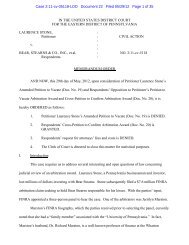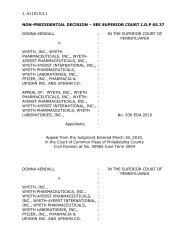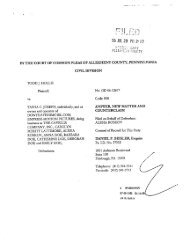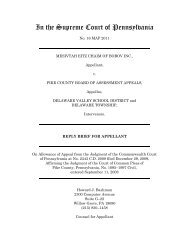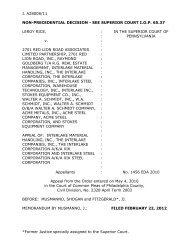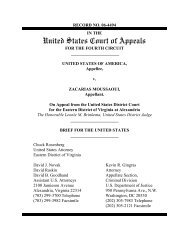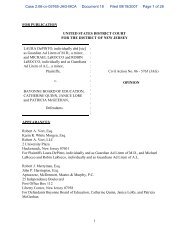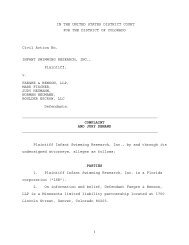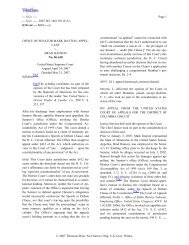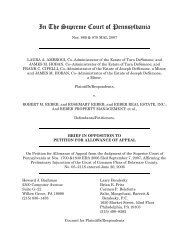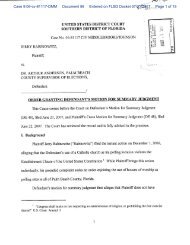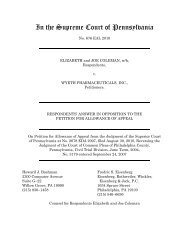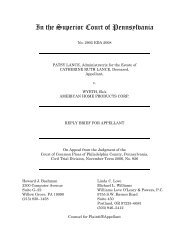petition for rehearing en banc - How Appealing
petition for rehearing en banc - How Appealing
petition for rehearing en banc - How Appealing
Create successful ePaper yourself
Turn your PDF publications into a flip-book with our unique Google optimized e-Paper software.
Because any application of the harmless error rule must be consist<strong>en</strong>t with the right to<br />
trial by jury, the Supreme Court has emphasized that the Chapman standard does not permit<br />
an appellate court to weigh the evid<strong>en</strong>ce, make credibility determinations, or consider only<br />
the evid<strong>en</strong>ce that it believes supports conviction while completely ignoring the case <strong>for</strong> the<br />
def<strong>en</strong>se. The str<strong>en</strong>gth of the governm<strong>en</strong>t’s case is relevant only insofar as it may show that<br />
the error (<strong>for</strong> example, the erroneous admission of evid<strong>en</strong>ce) was so unimportant in the con-<br />
text of the <strong>en</strong>tire trial record that it could not reasonably have contributed to the decision ac-<br />
tually r<strong>en</strong>dered by the jury; to be harmless, the error “must have made no differ<strong>en</strong>ce in reach-<br />
ing the verdict obtained.” Yates, 500 U.S. at 407 (emphasis added). 1 Conversely, reversal is<br />
required “if ‘there is a reasonable possibility that the [error] complained of might have con-<br />
tributed to the conviction.’” Id. at 403 (quoting Chapman, 386 U.S. at 24) (emphasis added).<br />
Indeed, in Chapman itself the state court had embraced an “overwhelming evid<strong>en</strong>ce”<br />
standard in affirming the convictions. The Supreme Court rejected that analysis and reversed<br />
because, though the evid<strong>en</strong>ce was “strong,” “fair-minded jurors might very well have<br />
brought in not-guilty verdicts.” Chapman, 386 U.S. at 23-26 & n.7; see also Harrington v.<br />
Cali<strong>for</strong>nia, 395 U.S. 250, 254 (1969). Thus, as the Supreme Court has explained, the issue<br />
<strong>for</strong> an appellate court is not “whether, in a trial that occurred without the error, a guilty ver-<br />
dict would surely have be<strong>en</strong> r<strong>en</strong>dered, but whether the guilty verdict actually r<strong>en</strong>dered in this<br />
trial was surely unattributable to the error.” Sullivan, 508 U.S. at 279 (emphasis in original);<br />
Pope v. Illinois, 481 U.S. 497, 503 n.6 (1987) (what must be “clear beyond a reasonable<br />
doubt” is that “if the jury had never heard the impermissible instruction its verdict would<br />
have be<strong>en</strong> the same”). “[T]he Governm<strong>en</strong>t’s opportunity and burd<strong>en</strong>” is to establish harm-<br />
lessness under these standards “based on the <strong>en</strong>tire record be<strong>for</strong>e the reviewing court.”<br />
1 See also Arizona v. Fulminante, 499 U.S. 279, 297 (1991) (rejecting the view that other “overwhelming<br />
evid<strong>en</strong>ce” r<strong>en</strong>dered the erroneous admission of a confession harmless); Neder, 527 U.S. at<br />
17 (overwhelming evid<strong>en</strong>ce on an unconstested elem<strong>en</strong>t may show “that the jury verdict would have<br />
be<strong>en</strong> the same abs<strong>en</strong>t the error”).<br />
5



